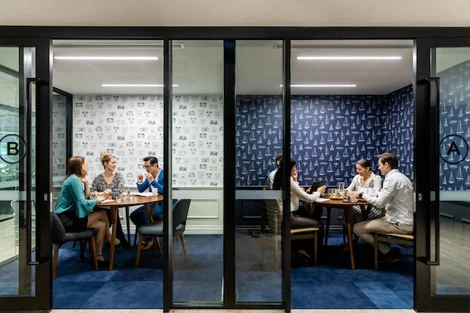
The Future of Work
SHARE

We’re living in the future.
It seems like a meaningless statement, but there’s something to it. The events of the past two years have turbocharged a revolution in the way we work. But it’s a revolution that had already been underway, and we’re just experiencing it much sooner than we otherwise would have.
It’s kind of like a time-warp.
But what is this future all about? In the case of office work, we’re in the process of fundamentally rearranging the way we work—where we work, when we work, how we communicate, and how we carry out work itself.
In the midst of this time-warp, it’s useful to take stock of what’s changing around us and how things are going to continue to change in the coming years.
The Future of Work
The Future of Remote Work
The biggest topic on everyone’s mind right now is how the remote working practices brought about by the pandemic will continue moving forward.
There’s been an explosion of press highlighting that many of the people forced to work from home for the first time during the pandemic will continue to do so afterwards. In Australia, the percentage of people working from home shifted from 8% prior to the pandemic to 40% now, and the suggestion is we’re not going to get close to 8% again.
There’s also been a lot of press focused on the benefits that working from home can bring to employees. Some of the pros that have been considered include having more opportunities to spend time with and take care of family, as well as having more time to do things like socialising and exercise.
Of course, many downsides have also been uncovered—the potential for employee isolation, for example, as well as decreased collaboration and productivity. As much as it’s often possible for people to work from home, at both individual and organisational levels, there are upsides to actually having an office for employees to come to.
While the return to office work is going to depend a great deal on the type of work that people do, it’s likely that the mass exodus from the office often spoken of will not actually occur. Consulting firm McKinsey has projected that, across 8 major economies, maximum productivity could be maintained if 20 to 25 per cent of employees worked from home for between three and five days out of each week.
Obviously, that still leaves a large chunk of the workforce at their place of business. Big questions then arise about which employees and which businesses should be adopting remote working arrangements.
As is often the case, things aren’t so straightforward. These days, most office workers are called upon to complete quite an array of types of tasks from day to day—not to mention week to week and month to month.
As well, most businesses are called upon to change the way they work over similar intervals. Businesses have to shift gears with changing clients, changing legislation, changing competitors, changing everything…
The upshot is that it’s not so cut and dry whether a given employee should work from home or not, or whether a given business should operate remotely.
The future of work is more nuanced than that.
The Future of Flexible Work
So, the buzzword of the moment is ‘flexible work’.
The pandemic has made us realise that we are all a lot more flexible than we thought we were. Who would have thought, before the pandemic, that hundreds of millions of people could start working from their bedrooms and kitchens overnight without bottling business operations altogether?
But now that we’ve worked that out, the focus should be on optimising working arrangements—finding out what the best balance is between remote and in-office work.
Corporations like Microsoft are putting flexibility at the core of their new business models, giving employees scope to choose not just where they work but also when they work. So why and how are the business leaders doing this?
Probably the biggest reason as to why the future of office has flexible work arrangements at its core is that top businesses recognise that offering flexibility is critical for attracting and maintaining the best professional talent.
This isn’t just a matter of finding people that are a bit better—it’s about finding people who are qualified to do the job in the first place.
All of the research suggests that Australia, like many countries throughout the world, is heading for a serious shortage of skilled workers. Consultancy PWC, for example, reports that 75% of Australian CEO’s are concerned that they won’t have enough highly skilled employees to meet their business needs in the coming years (and many businesses already can’t find the people they need).
This shortage comes about largely because global business operations are moving quickly towards higher-tech processes, requiring more skilled workers to facilitate them. Importantly, the global pandemic has turbocharged our progress towards new technologies, such as automation and robotics. Other technologies like workflow AI programs and virtual office technology have also developed (more on this later).
Overall, office work now requires more digital literacy than ever before, but also much higher standards of digital capability. We’ve moved beyond the need to know the ins and outs of Excel.
Making things all the more difficult for employers in Australia is that, the pandemic has halted the immigration of skilled workers, meaning the talent pool is smaller.
What all of this amounts to is that, in order to compete to find the right talent, businesses of the future need to be offering flexible work arrangements as an upfront perk for a lot of positions.
Another major reason that the future of work is flexible is that organisations are realising the importance of taking care of their most valuable assets—their people. And what those people are saying is pretty clear. It’s been reported, that 76% of employees don’t want to return to full-time office work, while a massive 93% want more flexibility in what hours they work.
The key to flexible working arrangements is understanding employees as individuals. What’s clear from all the polls that have been done since the pandemic restrictions got underway is that people are divided about whether or not they want to return to full-time on-site work.
And there are good reasons for this division. All sorts of things (like where we live, whether or not we have kids, and the extent of our other personal obligations) affect our preferences for working flexibly or not. So, setting up flexible work arrangements is something that really ought to be done on a case-by-case basis.
What the top organisations already understand about the future of flexible working arrangements is that they’re not just about being nice to your employees. The evidence suggests that, when we take individual preferences about where and when employees work, productivity goes up.
There are many reasons why this is the case, from allowing workers to get the sleep they need for optimal brain function to making them happier that they can spend more time with family. Beyond improving day-to-day productivity, improving employee well-being through flexible work helps business performance in other ways by reducing sick leave and employee turnover.
In sum, the future of work is going to be flexible for no better reason than it’s better for business.
The Future of Coworking
So, we know that the people working in future businesses will be working on a more flexible basis, but how flexible are the spaces they work in?
The same McKinsey research report on the future of work we referenced earlier has found that a major option that executives are now moving towards is flexible office space. Polling 278 executives in August 2020, researchers found that, on average, these leaders were looking to reduce their office spaces by 30% since the pandemic hit.
For many large corporations—tech giants like Google or Apple, for example—this descaling exercise might simply involve letting certain leases run out and using current infrastructure on a flexible basis.
But for the majority of companies throughout the world, this is impractical. Companies with fewer than 100 personnel, for example, can’t really lease a 50-person office space and try to use it flexibly. There is simply too little room for error.
What if a new client comes on board and ten more pairs of hands need to be hired? What if a client shuts up shop? There are so many variables that come into play that, while maintaining its own flexible office space may sound like a nice option for a business, doing so is very hard in practice.
But this is where coworking comes in as a viable option for millions of businesses worldwide. Coworking office spaces give businesses the opportunity to actually be flexible in the way they use the workplace.
If a business uses a coworking space, it means that they’re not committing to multi-year contracts in office spaces that may be too big or too small for them in 6 months or a year. Instead, they can contract to use more or less space over shorter intervals in a way that suits them.
What this means is that businesses can afford to maximise flexible working arrangements without having to pay a premium for it (or simply decreasing operational capability because they haven’t got enough space set up to do the work they want to do).
The future of coworking can be seen pretty clearly in commercial real estate projections. Right now coworking spaces are thought to take up 5% of the commercial real estate market. However, by 2030, that number is now expected to increase to 30%.
Cut it any way you like, more and more companies are looking to hop onto this business trend to improve operational efficiency.
Coworking office spaces are a big part of the future of work.
The Future of Office Technology
The last of the major business trends we have to address is the steep rise in our reliance on technologies to keep work running smoothly within our new organisational setups.
Front and centre here is the rise in teleconference software—Zoom, for example, saw a 317% increase in use between 2019 and 2020. By now, most of us have had a conference call with our boss while wearing pyjama-bottoms on, or have seen family pets stroll in and out of team meetings. But is teleconferencing really the future of office tech?
Of course, being able to set up all types of team and client meetings on the fly when people are working remotely is going to be essential in the future. But the true tech change that we are likely to see is going to have less to do with faces on screens and more to do with the sharing and processing of data.
We saw over the last decade an explosion in the use of cloud computing programs throughout office-based businesses. Programs like Azure and OpenStack allow employees to share information and digital resources in real-time.
Once again the movement towards cloud computing is something that the global pandemic has dramatically accelerated. This acceleration has occurred, in large part, because employees have needed to streamline their work efforts from remote locations.
But the future demand for cloud computing is more sophisticated, stemming from a necessity to incorporate automation, AI, and large-scale data analytics into business operations. Cloud computing allows organisations to not only integrate resources and streamline processes, but also to collect information about them, analyse them, learn how to organise them more intelligently, and automate where possible.
The Future Belongs to Those Who Act in the Present
To sum it up, the global pandemic has zoomed us into the future (pun intended), accelerating processes of change that might have taken a decade or more.
Most importantly, this acceleration has placed far more pressure on businesses to keep up with the pace. It’s a simple matter of accepting and reacting to the kind of work future we’ve been talking about or to fall behind the pack.
Related articles


Wellness in the Workplace: How to Manage Stress at Work


